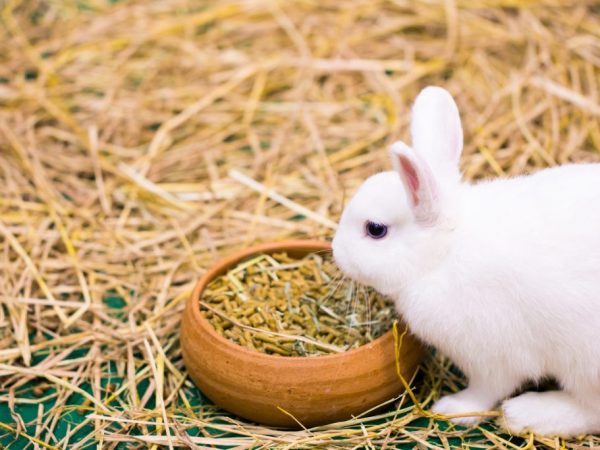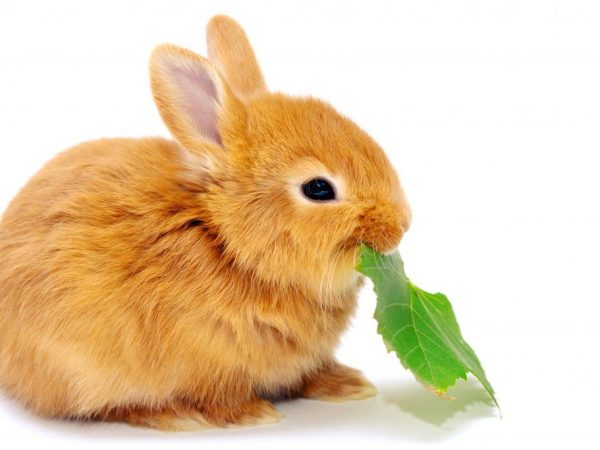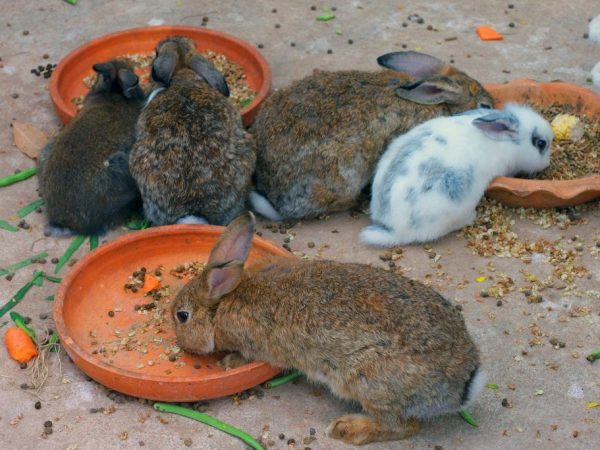How many times a day should rabbits be fed
To raise healthy and strong animals, you need to know the characteristics of their diet. How many times a day should rabbits be fed? Let us analyze what and in what quantity should be given to the eared, so that there are no problems in the future.

Rabbit feeding rules
Nutrition Basics
It is difficult for novice livestock breeders to understand the intricacies of breeding, so they often make certain mistakes. No need to calculate the ratio of protein to carbohydrates per month on a calculator. Knowing the basics of feeding can help you avoid getting into trouble.
- Quality products. It is forbidden to give rotten and moldy food. Food that is damp, frozen or covered with frost is a source of disease.
- A varied menu. Even the most delicious diet quickly becomes boring. Rabbits are more sensitive to food, so it is important to offer them different types.
- Water. Dry food is better absorbed only with an abundance of fresh liquid. The lack of an important element is first of all reflected in the form of constipation and lack of milk in lactating females.
- Food is served at a specific time. The animals quickly get used to the schedule and wait for food.
- You cannot feed all groups equally. The daily allowance for each type of rabbit is different.
The Eared Ears eat at least 30 times in 24 hours. According to Mikhailov's system, animals have regular access to food. In nature, the rodent constantly finds twigs or grass, so the body receives nutrients in sufficient quantities. In this case, the livestock grows up healthy and strong, without a single hint of obesity.
With cellular maintenance, it is imperative to receive not only plant food, but also animal products. Experienced breeders provide fish oil, bone meal and whole milk with whey. It is useful to give silage with the addition of beets, potatoes and concentrate. Be sure to include trace elements.
Feeding mode
Rabbits eat very often, so it seems to beginners that the animal is constantly chewing something. Farms prefer two meals a day: in the morning and in the evening. At home, three times a day of feeding is practiced:
- in winter - at 8, 12 and 17 o'clock;
- in summer - at 6, 15 and 19.

Rabbit diet
In cold weather, in the morning and in the evening, give half the ration of the concentrate (grain) and the same amount of silage. It is better to feed with root vegetables at noon. In warm seasons, dry food (50%) and grass are preferred at the beginning and end of the day. Dried greens are divided into 3 portions and added each time.
Such a diet will help to quickly build muscle mass in animals. Always check for drinking water. In cold weather, the liquid must be warmed up to room temperature.
Fattening
Meat breeds are grown according to a specific pattern. It is important not only to gain weight in a few weeks, but also to get an excellent ratio of meat to body condition. Experienced breeders recommend starting the process 42 days before the intended slaughter.
What and how many times a day to feed rabbits? More than 50% of the menu consists of concentrates, and to increase fat, it is recommended to give boiled potatoes, corn and barley.Sometimes peas and oats are allowed, and parsley and dill are mixed with hay.
The animals should move less and gain weight faster. To do this, their movement is limited to a cage in which no more than 6 eared heads sit. They are sent for slaughter after individuals become lazy and are not interested in food.
Diet during mating
To get healthy and strong rabbits, you need to take care of the condition of future parents. The thin are provided with enhanced nutrition, and the fat ones are transferred to a diet. Lack or excess of fat leads to stillbirth, and in males, the quality of sperm decreases.
Enhanced feeding of emaciated individuals begins one month before the mating period. It is necessary to increase the daily ration, bringing it closer in nutritional value to the menu of foster ladies. The abundance and variety are complemented by multivitamins.
To improve the quality of sperm in males, you need to use protein foods. For enrichment, oilseed cake, meat and bone meal and fish meal are added to food. During the mating period, products that contribute to obesity cannot be used, therefore, exclude:
- barley;
- corn;
- potatoes.
The vitality of the rabbits depends on the health of the producing animals. It is advised to provide a complete and varied diet with a sufficient amount of useful trace elements. Veterinary supplements can be used at this stage.
What should the rabbit eat during the resting period? The usual diet consists of a third of grain and 70% of hay. They add to food (in grams per head):
- salt - 1;
- bone meal - 4;
- ground shell - 2.
Features of the female menu
There are a lot of pregnant rabbit. Obese mothers find it difficult to give birth. Before okrol, the daily rate is reduced, but starvation is not allowed. Lack of nutrients leads to a delay in the natural development of the fetus.
One rabbit eats 60 to 100 g of vegetable feed (oats, concentrate, legumes) per day. Additionally, sunflower or soybean meal is added - no more than a third of the norm. Since there is no lactation yet, half a kilogram of grass is enough.
Do not forget about carrots and potatoes: 250 g for each head. Fetal females must be given minerals and vitamins, and fish oil and meat and bone meal are suitable as natural supplements. It is important to monitor the quality of the water.
After childbirth, you need to increase lactation. The nursing rabbit eats green grass in summer, and in cold seasons it is better to give root crops, hay and silage. Feeding rates are increased in the period from 20 to 45 days (in grams per individual):
- compound feed - 150;
- juicy menu - 300;
- grass - 1000.
Lactating females need to consume 60-70 g of protein per day with feed. Their feed should contain at least 17-18% of an important product.
The little ones watch their mother and soon begin to try adult food themselves. To prevent the rabbit from starving, it is necessary to add to the daily dose 30 g of concentrate and hay in winter, and in summer - 25 and 60. In this case, you can not worry about the lack of food and a decrease in lactation.
Features of the menu of young animals
Feeding rabbits has its own subtleties. It is better to plant babies in the period from 30 to 45 days after birth. If breast milk is deprived at an earlier age, the digestive system of young people will not have time to form properly. Any "adult" diet is not suitable for eating crumbs, so everything new is introduced gradually.

Feeding young rabbits
Experienced farmers prefer to use granular concentrate. The daily feed rate for young rabbits is (in grams per head):
- up to 2 months - from 85 to 125;
- up to 90 days - from 130 to 170;
- from week 13 - from 180 to 200.
By the way, the menu can be diversified with herbs and hay. The compound feed is reduced to 85%, and the remaining 15% is used for grass. In the morning, give half the daily allowance of dry food, and in the evening, add root vegetables to the remainder. During the day, it is recommended not to forget about silage. Wet types of food are given in such a way that they are eaten for 1.5 hours.
Summer feeding
Warm seasons are a great time to diversify the animal menu. The basis of the diet is both grass and leaves of radish, carrots. The eared ones absorb the branches of fruit tree varieties well. It is not forbidden to offer apples, cabbage and their scraps.
Sugar and red beets should not be given in large quantities. Foods cause gas to build up, which can lead to bloating. It is allowed to use fodder types of root crops. To improve digestion, give fragrant herbs:
- sagebrush;
- dill;
- yarrow;
- chicory.
Dried garlic stalks are used to prevent dental problems, and plantain is a natural antibiotic. Young nettles will become a natural source of vitamins. By the way, such a delicacy can be given to both a nursing rabbit and meat species.
How much greenery is allowed per pet? On average, adults eat up to 600 g of grass, rabbits - from 150 g or more. The content of lactating mothers allows you to double the rate. Using this type of diet reduces dry food intake and conserves concentrates.
Winter feeding
In cold seasons, animals are often deficient in vitamins. Trace elements A, D, E and B12 must be added to the daily feed requirements for rabbits. High-quality hay and fermented green food will provide the body with important components. Fish oil is added once a day (in grams per head):
- rabbits - 0.5;
- lactating females - 3;
- pregnant women - 2;
- the rest of the animals - 1.
Sprouted grains are rich in vitamin E, so they are regularly given to both toddlers and adults. If there is no time to grow greens, then sometimes it can be replaced with yeast. Within 5 days, one individual is fed up to 6 g of bakery product. Then take a break for 72 hours and repeat again.

How to feed rabbits in winter
Turnips, cabbage and dry grass are fermented in barrels for the winter. Add carrots and salt (1% of the total weight). For an adult animal, such food should be no more than 300 g, and for young animals, 100 g per head is enough. To prevent vitamin deficiency, experienced farmers sometimes provide needles of coniferous crops.
How much should a rabbit eat in winter? During this period, 50% of the total ration is made up of concentrates, and the rest is silage and juicy foods. Carbohydrates, which can be obtained from boiled root crops, are perfectly absorbed.
Things to remember
Eared pets love to chew on something, so you need to be careful about food of animal origin. Dairy products are included in the menu in limited quantities. 10 g per day are allowed per individual, which are used both raw and added to the mash.
The rabbit needs to eat the grain, but experienced farmers advise to grind large grains in a grinder beforehand. Such food is digested without problems and does not cause rejection in young animals. During feeding, you need to carefully monitor the taste preferences of the pets and do not allow unloved components to be scattered.
Eared people cannot eat fresh bread. It is better to cut the product into small pieces and dry in the oven. Croutons are used as an additional treat. Do not get carried away with waste from the table and give food with an abundance of spices and salt.
Autumn and spring are a period of transition from one type of food to another. It is not advised to carry out the procedure abruptly, otherwise digestive problems can be provoked. The gradual introduction of new types of food should be done within 7 days. If diarrhea has begun, then the animals should be given oak twigs.
Knowing the norms of feeding rabbits per day for 1 head, you can accurately calculate the consumption of a particular product per month. Our recommendations will help you find the optimal menu for each stage of animal life. Thanks to the knowledge of seasonal characteristics, it is easy to adjust the diet.



